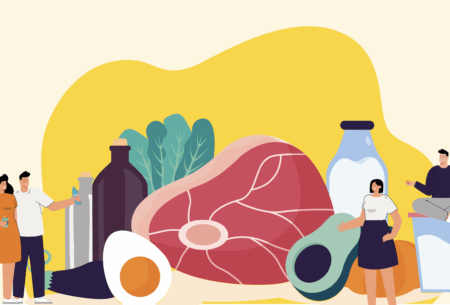Histamine intolerance occurs when there is a build up of histamine in the body.
It is thought to happen when there is reduced breakdown of histamine in the gut due to a lack of the enzyme, diamine oxidase (DAO). This concept is similar to lactose intolerance when our bodies have too little of the enzyme lactase to digest lactose in dairy products. Reduced levels of DAO can be caused by genetic factors, as a result of damage to the gut lining due to disease, or as the result of medications diminishing the effects of DAO.
More recently, studies have demonstrated that patients with symptoms of histamine intolerance have an imbalance of the gut microbiota and an increased abundance of histamine secreting microbes. Some people may experience problems because their body releases histamine too easily, or increased stress levels may reduce their tolerance. Histamine intolerance is complex!
What is histamine?
Histamine is a chemical, a ‘biogenic amine’. It has many important functions but is most well known as histamine being released by our body during an allergic reaction. This is why symptoms can often be mistaken for food allergy. However, histamine intolerance is classified as a ‘pharmacological food hypersensitivity’ rather than a food allergy.
When histamine levels rise, it results in a wide range of symptoms including:
- gastrointestinal symptoms, such as abdominal distension, pain and diarrhoea
- nerve symptoms, such as headaches
- cardiovascular symptoms, such as low blood pressure, dizziness, and irregular heartbeat
- skin symptoms including, facial flushing, itching and rash
- respiratory symptoms (rhinitis, sneezing), although these are less common
Diagnosing histamine intolerance
There are currently no reliable tests to diagnose histamine intolerance. Some tests measure the amount of DAO in the blood (low DAO serum level is considered to be <10 U/mL) but this does not reflect DAO activity in the gut where histamine is digested.
Which foods are involved?
It is important to understand how histamine is produced to get a better understanding of which foods contain it.
How is histamine produced?
Histamine is produced by certain spoilage bacteria that predominantly live in fish, cheese and fermented foods. The histamine chemical can also occur naturally in some plant foods (the highest being aubergine, spinach and tomato) but these contain much much less histamine than aged or fermented foods. For example, levels of histamine in cheddar can range from 0-2000mg/kg compared with aubergine, which is on average 35mg/kg.
Understanding high levels of histamine:
Such high levels can be produced in fish and fermented foods that the food safety authority monitors for ‘histamine intoxication’. Monitoring is due to the high levels of histamine that are produced by bacteria if the fish (especially tuna/mackerel) are improperly preserved or refrigerated. A lack of proper preservation and temperature control is the most common cause of fish food poisoning.
Histamine intoxication symptoms include skin flushing, rash, vomiting/diarrhoea, and a throbbing headache. Most cases of histamine intoxication have occurred at levels 200mg/kg, and often above 500mg/kg.
The science:
Some foods have been described as ‘histamine liberators’ however, the mechanism is not fully understood and, as yet, there have been no conclusive lab or animal studies. What is understood is that some foods contain more than one biogenic amine (e.g. citrus fruits and banana are high in putrescine) which can also result in symptoms. One study showed that only 35% of foods listed on low histamine diets can be justified as being genuinely ‘low histamine’.
Be wary of long lists of ‘high histamine’ foods and always remember that the level of histamine can vary greatly, even in the same types of food. A good rule of thumb is that foods which are fermented or aged are likely to contain more histamine than fresh foods.
Management
If you are suffering from histamine intolerance (and have undertaken supervised diagnosis, as above), then here are a few tips:
- always choose fresh foods, where possible
- for plant foods, boiling them or consuming at maximum freshness is recommended
- it is better to freeze meals as soon as possible rather than leave them in the fridge
- histamine is not affected by heat, so foods already high in histamine will remain so whether they are cooked or re-heated
- medications such as second-generation antihistamines can help, and DAO supplements have been shown to improve symptoms in some people. However they are not widely available on prescription and can be costly
A final note
Many people with long covid are opting for low histamine diets, as this is increasingly being discussed online as offering some therapeutic benefits. It is not yet fully understood whether patients with long covid have true histamine intolerance or an overly active immune system – if you are in this position, consult with a registered dietitian who can review your case and offer guidance.
Expert support can help to avoid an unnecessarily over-restrictive diet! If you would like some personalised advice, we can support your journey and symptoms of histamine intolerance here at The Gut Health Clinic.
Book here to see me at The Gut Health Clinic where I’d be happy to help!
References:
Comas-Baste O, Sanchez-Perez S, Veciana-Nogues MT, Latorre-Moratalla M, Vidal-Carou MDC. Histamine Intolerance: The Current State of the Art. Biomolecules. 2020;10(8). Available from: doi: 10.3390/biom10081181.
Reese I, Ballmer-Weber B, Beyer K, Fuchs T, Kleine-Tebbe J, Klimek L, et al. German guideline for the management of adverse reactions to ingested histamine: Guideline of the German Society for Allergology and Clinical Immunology (DGAKI), the German Society for Pediatric Allergology and Environmental Medicine (GPA), the German Association of Allergologists (AeDA), and the Swiss Society for Allergology and Immunology (SGAI). Allergo J Int. 2017;26(2):72-9. Available from: doi: 10.1007/s40629-017-0011-5.
Sanchez-Perez S, Comas-Baste O, Veciana-Nogues MT, Latorre-Moratalla ML, Vidal-Carou MC. Low-Histamine Diets: Is the Exclusion of Foods Justified by Their Histamine Content? Nutrients. 2021;13(5). Available from: doi: 10.3390/nu13051395.Schnedl WJ, Enko D. Histamine Intolerance Originates in the Gut. Nutrients. 2021;13(4). Available from: doi: 10.3390/nu13041262.












